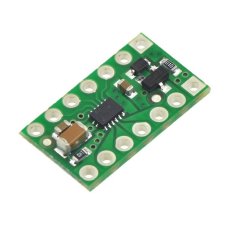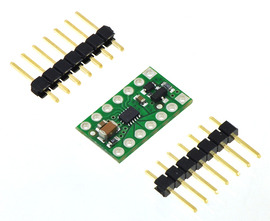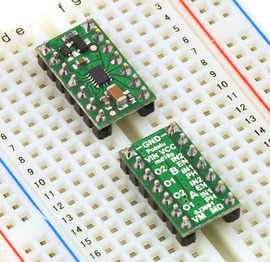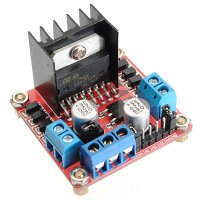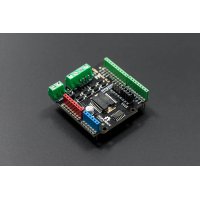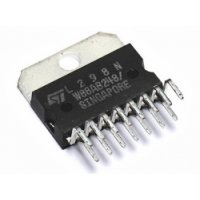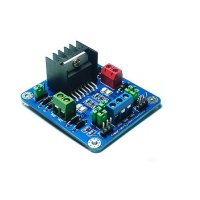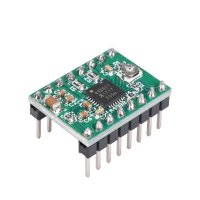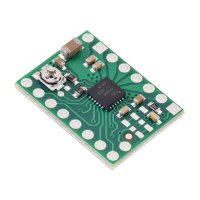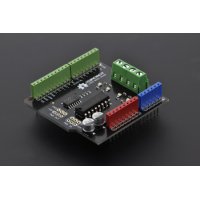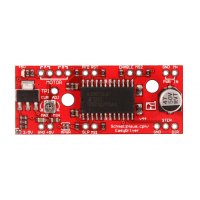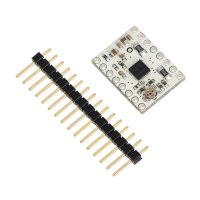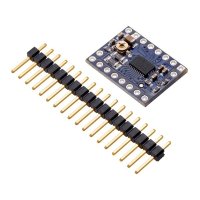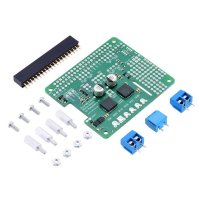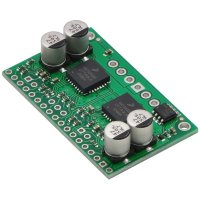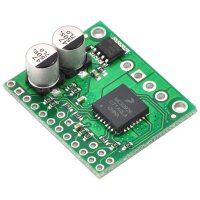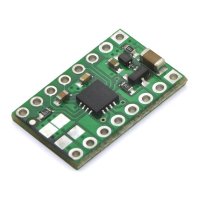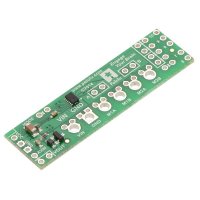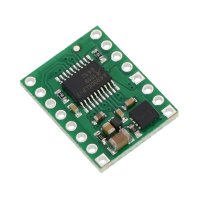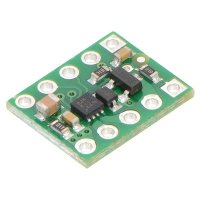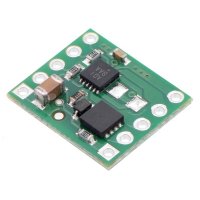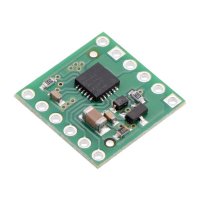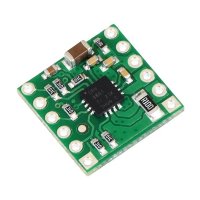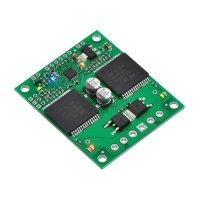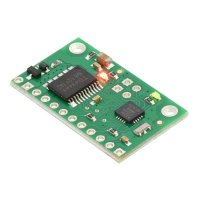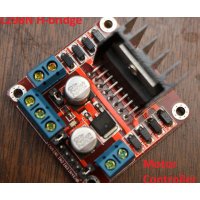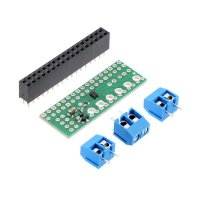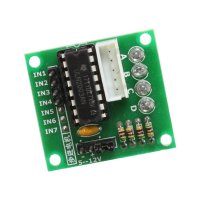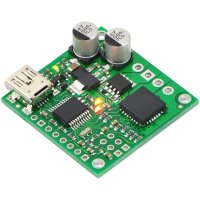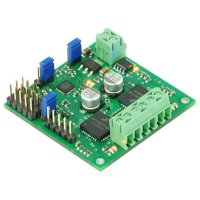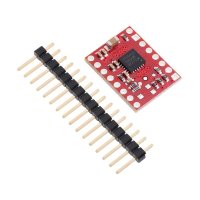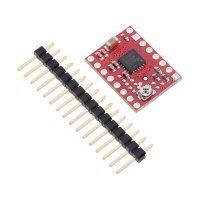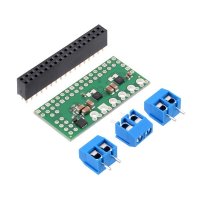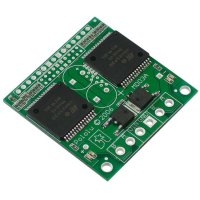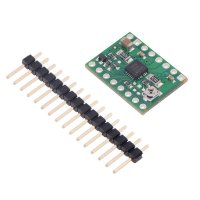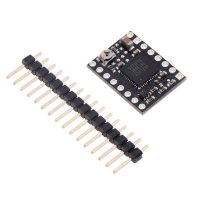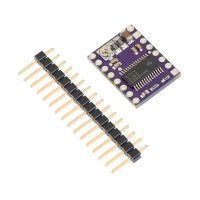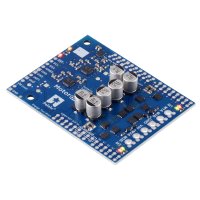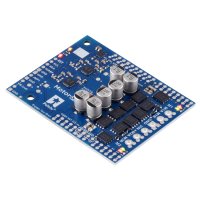This tiny breakout board for TI’s DRV8835 dual motor driver can deliver 1.2 A per channel continuously (1.5 A peak) to a pair of DC motors, and it supports two possible control interfaces for added flexibility of use: IN/IN and PHASE/ENABLE. With an operating voltage range from 0 V to 11 V and built-in protection against reverse-voltage, under-voltage, over-current, and over-temperature, this driver is a great solution for powering up to two small, low-voltage motors. The carrier board has the form factor of a 14-pin DIP package, which makes it easy to use with standard solderless breadboards and 0.1″ perfboards.
Texas Instruments’ DRV8835 is a tiny dual H-bridge motor driver IC that can be used for bidirectional control of two brushed DC motors at 0 V to 11 V. It can supply up to about 1.2 A per channel continuously and can tolerate peak currents up to 1.5 A per channel for a few seconds, making it an ideal driver for small motors that run on relatively low voltages. The DRV8835 is a great IC, but its small, leadless package makes it difficult for the typical student or hobbyist to use; our breakout board gives this driver the form factor of a 14-pin DIP package, which makes it easy to use with standard solderless breadboards and 0.1″ perfboards. Since this board is a carrier for the DRV8835, we recommend careful reading of the DRV8835 datasheet (1MB pdf). The board ships populated with SMD components, including the DRV8835, and adds a FET for reverse battery protection.
Alternative driver options
This board is very similar to our DRV8833 dual motor driver carrier in operating voltage range and continuous current rating, but the DRV8835 has a lower minimum operating voltage, offers an extra control interface mode, and is 0.1″ smaller in each dimension. The DRV8833 has a higher peak current rating (2 A per channel vs 1.5 A), optional built-in current-limiting, and no need for externally supplied logic voltage.
For a smaller, lower-cost, single-channel alternative to this driver, please consider ourDRV8838 carrier. The DRV8838 has the same operating voltage range as the DRV8835 and very similar current capabilities, and it uses the same PHASE/ENABLE control interface.
For higher-voltage alternatives to this driver, consider our A4990 and DRV8801 motor driver carriers.
We also carry a DRV8835 dual motor driver Arduino shield that makes it easy to incorporate this great driver into an Arduino project, as well as a DRV8835 motor driver kit for the Raspberry Pi.
Features
- Dual-H-bridge motor driver: can drive two DC motors or one bipolar stepper motor
- Motor supply voltage: 0 V to 11 V
- Logic supply voltage: 2 V to 7 V
- Output current: 1.2 A continuous (1.5 A peak) per motor
- Motor outputs can be paralleled to deliver 2.4 A continuous (3 A peak) to a single motor
- Two possible interface modes: IN/IN (outputs mostly mirror inputs) or PHASE/ENABLE (one pin for direction and another for speed)
- Inputs are 3V- and 5V-compatible
- Under-voltage lockout on the logic supply and protection against over-current and over-temperature
- Reverse-voltage protection on the motor supply
- Compact size (0.7″×0.4″) with the form factor of a 14-pin DIP package
Included hardware
|
|
Two 1×7-pin breakaway 0.1″ male headers are included with the DRV8835 dual motor driver carrier, which can be soldered in to use the driver with breadboards, perfboards, or 0.1″ female connectors. (The headers might ship as a single 1×14 piece that can be broken in half.) The right picture above shows the two possible board orientations when used with these header pins (parts visible or silkscreen visible). You can also solder your motor leads and other connections directly to the board.
Using the motor driver
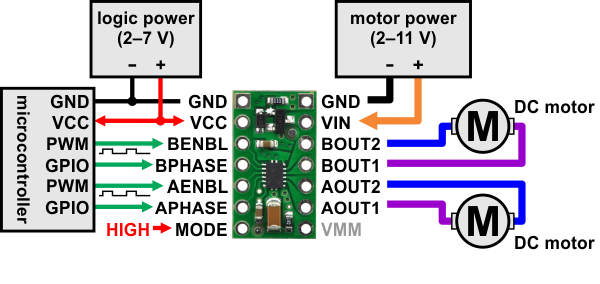 |
|
Minimal wiring diagram for connecting a microcontroller to a DRV8835 dual motor driver carrier in phase-enable mode. |
|---|
Motor and motor power connections are made on one side of the board and logic power and control connections are made on the other. The driver requires a motor voltage between 0 V and 11 V to be supplied to the VIN or VMM pin and a logic voltage between 1.8 V and 7 V to be supplied to the VCC pin; the logic voltage can typically be supplied by or shared with the controlling device. The VIN pin is the reverse-protected motor supply input and is the recommended point for connecting motor power. However, driver performance will start getting worse when the input voltage to the reverse-protection circuit is below a few volts, and 1.5 V is the lower limit of where the VIN pin can be used. For very low voltage applications, the motor supply should be connected directly to VMM, which bypasses the reverse-protection circuit.
The DRV8835 features two possible control modes: IN/IN and PHASE/ENABLE. The MODE pin determines the control interface. Each control input is pulled low through a weak pull-down resistor (approximately 100 kΩ), so the driver will be in the IN/IN mode if the MODE pin is left disconnected, and the driver outputs will be disabled by default. Setting the MODE pin high, either with a pull-up resistor or a driving-high I/O line, sets the driver to PHASE/ENABLE mode, where the PHASE pin determines the motor direction and the ENABLE pin can be supplied with a PWM signal to control the motor speed. This mode is generally easier to use as it only requires one PWM per channel, but it only allows for drive/brake operation. (Drive/brake operation usually provides a more linear relationship between PWM duty cycle and motor speed than drive/coast operation, and we generally recommend using drive/brake operation when possible.)
| Simplified drive/brake operation with MODE=1 (PHASE/ENABLE) | ||||
|---|---|---|---|---|
| xPHASE | xENABLE | xOUT1 | xOUT2 | operating mode |
| 0 | PWM | PWM | L | forward/brake at speed PWM % |
| 1 | PWM | L | PWM | reverse/brake at speed PWM % |
| X | 0 | L | L | brake low (outputs shorted to ground) |
Advanced usage with IN/IN mode
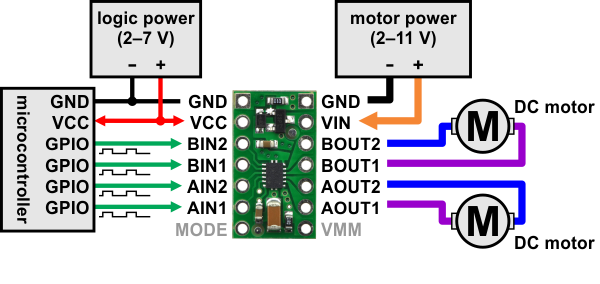 |
|
Minimal wiring diagram for connecting a microcontroller to a DRV8835 dual motor driver carrier in in-in mode. |
|---|
When the MODE pin is disconnected or low, the control interface is IN/IN, which allows for slightly more advanced control options. The following truth table show how to achieve drive/coast and drive/brake operation using the IN/IN control interface:
| Drive/coast or drive/brake operation with MODE=0 (IN/IN) | ||||
|---|---|---|---|---|
| xIN1 | xIN2 | xOUT1 | xOUT2 | operating mode |
| 0 | 0 | OPEN | OPEN | coast (outputs off) |
| PWM | 0 | PWM | L | forward/coast at speed PWM % |
| 0 | PWM | L | PWM | reverse/coast at speed PWM % |
| 1 | PWM | PWM | L | forward/brake at speed 100% − PWM % |
| PWM | 1 | L | PWM | reverse/brake at speed 100% − PWM % |
| 1 | 1 | L | L | brake low (outputs shorted to ground) |
Pinout
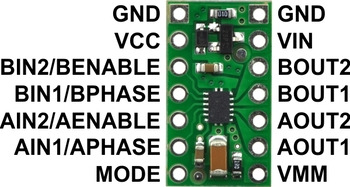 |
| PIN | Default State | Description | ||||||||||||||||||
|---|---|---|---|---|---|---|---|---|---|---|---|---|---|---|---|---|---|---|---|---|
| VIN | Reverse-protected motor power supply input. While the driver can operate from a motor supply of 0 V to 11 V, the reverse-protection circuit will start negatively affecting performance below a few volts, and 1.5 V is the lower limit of where it can be used. Power can be supplied directly to VMM to bypass the reverse-protection circuit. | |||||||||||||||||||
| VCC | 1.8 V to 7 V logic power supply connection. Logic supply current draw is typically only a few milliamps at most, so in many applications this pin can optionally be dynamically powered by a microcontroller digital output. | |||||||||||||||||||
| VMM | This pin gives access to the motor power supply after the reverse-voltage protection MOSFET (see the board schematic below). It can be used to supply reverse-protected power to other components in the system. It is generally intended as an output, but it can also be used to supply board power (such as in cases where the motor supply voltage is too low for the reverse-protection circuit). | |||||||||||||||||||
| GND |
Pololu 2135 DRV8835 Dual Motor Driver Carrier
Related ProductsL298N Motor Driver BoardThe L298N driver module, using ST' L298N chip, can directly drive two 3-30V DC motor, and provide a .. रo 195.00 L298P 2A Motor Shield For ArduinoThis DFRobot Arduino Compatible Motor Shield (2A) uses L298P chip which allow to drive two 7-12V DC.. रo 1,183.00 रo 1,364.00 L298N - Dual Full Bridge DriverThe L298N is a high voltage, high current, dual full bridge driver designed to accept standard TTL l.. रo 150.00 L298 Dual H-Bridge Motor DriverDouble H driver module uses ST L298N dual full-bridge driver, an integrated monolithic circuit in a .. रo 2,519.00 Stepper Motor Driver A4988A4988 is a complete microstepping motor driver with built-in translator for easy operation. This pro.. रo 140.00 Pololu 3764/3765 DRV8434A Stepper Motor Driver CarrierThis breakout board for TI’s DRV8434A microstepping bipolar stepper motor driver offers microsteppin.. रo 1,057.00 रo 1,101.00 1A Motor Shield for Arduino1A Motor Shield for Arduino This Motor shield for Arduino uses L293 chip which allow to dri.. रo 1,502.00 रo 1,730.00 Stepper Motor Driver - Easy Driver A3967Each Easy Driver can drive up to about 750mA per phase of a bi-polar stepper motor. It defaults to 8.. रo 210.00 Pololu 2134 / 2874 DRV8834 Low-Voltage Stepper Motor Driver CarrierThis is a breakout board for TI’s DRV8834 microstepping bipolar stepper motor driver. It has a pinou.. रo 602.00 रo 628.00 Pololu 2971 DRV8880 Stepper Motor Driver CarrierThis breakout board for TI’s DRV8880 microstepping bipolar stepper motor driver features adjustable .. रo 917.00 रo 955.00 Pololu Dual 2755/2756 MC33926 Motor Driver for Raspberry PiThis add-on board enables a Raspberry Pi B+, A+, Pi 2, or Pi 3 to drive a pair of bru.. रo 2,802.00 रo 2,919.00 Pololu 1213 Dual MC33926 Motor Driver CarrierThis dual brushed DC motor driver, based on Freescale’s MC33926 full H-bridge, has a wide operating .. रo 2,802.00 रo 2,919.00 Pololu 1212 MC33926 Motor Driver CarrierThis breakout board for Freescale’s MC33926 full H-bridge has an operating range of 5 – 28 V and can.. रo 1,512.00 रo 1,575.00 Pololu 2130 DRV8833 Dual Motor Driver CarrierThis tiny breakout board for TI’s DRV8833 dual motor driver can deliver 1.2 A per channel continuous.. रo 754.00 रo 786.00 Pololu 2511 DRV8835 Dual Motor Driver Shield for ArduinoThis small shield is an easy, economical way to control two small brushed DC motors with an Arduino .. रo 679.00 रo 707.00 Pololu 2137 A4990 Dual Motor Driver CarrierThis compact breakout board makes it easy to use Allegro’s A4990 dual motor driver, which can contro.. रo 608.00 रo 633.00 Pololu 2990 DRV8838 Single Brushed DC Motor Driver CarrierThis tiny breakout board for TI’s DRV8838 motor driver can deliver a continuous 1.7 A (1.8 A peak) t.. रo 340.00 रo 354.00 Pololu 2961 MAX14870 Single Brushed DC Motor Driver CarrierThis compact breakout board for Maxim’s MAX14870 motor driver offers a wide operating voltage range .. रo 754.00 रo 786.00 Pololu 2960 BD65496MUV Single Brushed DC Motor Driver CarrierThis compact breakout board for ROHM’s BD65496MUV motor driver offers an operating voltage range of .. रo 1,071.00 रo 1,275.00 Pololu 2136 DRV8801 Single Brushed DC Motor Driver CarrierThis tiny breakout board for TI’s DRV8801 provides a modern alternative to classic motor drivers suc.. रo 1,044.00 रo 1,087.00 Pololu 1112 Qik 2s12v10 Dual Serial Motor ControllerThis powerful motor controller allows variable speed and direction control of two large, brushed DC .. रo 14,110.00 Pololu 1110 Qik 2s9v1 Dual Serial Motor ControllerThis small, inexpensive motor controller allows variable speed and direction control of two small, b.. रo 3,551.00 L298 Dual H-Bridge Motor Driver ModuleNew L298 Dual H-Bridge Motor Driver Features: Working mode: H bridge .. रo 235.00 Pololu 2753 DRV8835 Dual Motor Driver Kit for Raspberry PiThis compact expansion board plugs directly into the GPIO header on a Raspberry Pi B+, Pi A+, Pi 2, .. रo 754.00 रo 786.00 ULN2003 Stepper Motor Driver BoardULN2003 Stepper Motor Driver Board A B C D four-phase LED indicates the status of the .. रo 74.00 Pololu 1392/1394 Jrk 21v3 USB Motor Controller with FeedbackThe jrk 21v3 motor controller is a highly configurable brushed DC motor controller that supports fou.. रo 5,638.00 रo 5,873.00 Pololu 767 TReX Jr Dual Motor Controller DMC02This lower-power, smaller, and lower-cost version of the TReX is the ultimate general-purpose motor .. रo 11,948.00 रo 14,110.00 Pololu 2968 / 2969 Stepper Motor Driver Carrier, Digital Current Control MP6500This product is a carrier board or breakout board for the MP6500 stepper motor driver from Monolithi.. रo 520.00 रo 549.00 Pololu 2966 / 2967 Stepper Motor Driver Carrier, Potentiometer Current Control MP6500This product is a carrier board or breakout board for the MP6500 stepper motor driver from Monolithi.. रo 527.00 रo 549.00 Pololu 3758/3759 Dual MAX14870 Motor Driver for Raspberry PiDual MAX14870 Motor Driver for Raspberry Pi, top view with dimensions. This .. रo 1,892.00 रo 1,971.00 Pololu 707/708 VNH2SP30/VNH3SP30 Dual Motor Driver Carrier MD03A 708 707The Pololu dual high-power motor drivers are compact carriers for the VNH3SP30 and VNH2SP30 motor dr.. रo 14,932.00 रo 17,634.00 Pololu 2878 / 2879 STSPIN820 Stepper Motor Driver CarrierThis breakout board for STMicro’s STSPIN820 microstepping bipolar stepper motor driver offers micros.. रo 1,532.00 रo 1,595.00 Pololu 3098 / 3099 Stepper Motor Driver Compact Carrier TB67S279FTGThis breakout board for Toshiba’s TB67S279FTG microstepping bipoloar stepper motor driver is arrange.. रo 816.00 रo 850.00 Pololu 2133 / 2982 DRV8825 Stepper Motor Driver Carrier, High CurrentThis breakout board for TI’s DRV8825 microstepping bipolar stepper motor driver features adjustable .. रo 1,286.00 रo 1,339.00 Pololu Motoron 5038/5037/5036 M2S18v18 Dual High-Power Motor Controller Shield for ArduinoThe Motoron M2S18v18 Dual High-Power Motor Controller Shield for Arduino makes it easy to control tw.. रo 5,704.00 रo 5,942.00 Pololu 5044/5043/5042 Motoron M2S18v20 Dual High-Power Motor Controller Shield for ArduinoThe Motoron M2S18v20 Dual High-Power Motor Controller Shield for Arduino makes it easy to control tw.. रo 11,262.00 रo 11,731.00 Tags: DRV8835, Dual, Motor, Driver, Carrier The product is currently Out-of-Stock. Enter your email address below and we will notify you as soon as the product is available. Name
Email
Phone
Comments
| |||||||||||||||||||

